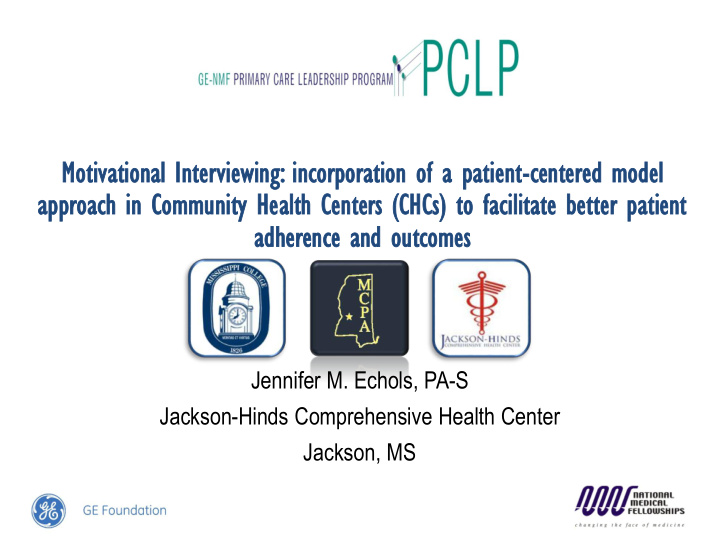



Motivat vational onal Inter ervie viewing wing: inco corpora rporation tion of a p a pat atient ient-cent center ered ed model el ap appr proach oach in Co Commun unity ity He Heal alth th Ce Centers ters (CH CHCs Cs) ) to fac acili litate tate bet etter er pat atien ent ad adheren herence ce an and d outcom comes es Jennifer M. Echols, PA-S Jackson-Hinds Comprehensive Health Center Jackson, MS
Introduction • My Background • Motivational Interviewing: What is it and why it is important to Jackson-Hinds? • Proposed intervention: • Introduce JHCHC providers to MI with basic training and assesses willingness to apply this tool • Provide professional training contact information and additional literature on implementing strategies for long-term, consistent incorporation of Motivational Interviewing in order to improve patient adherence and outcomes, as well as clinic overall clinic productivity in the future.
Background • Motivational interviewing created in 1983 by William Miller, Ph.D. and Stephen Rollnick, Ph.D • MI has been empirically tested extensively with repeated demonstration of efficacy in improving patient adherence and overall health outcomes. • motivational interviewing is just as effective as other behavior-modifying strategies • This is clinically significant due to the fact that similar results can be seen in a shorter amount of time, making MI more time and cost effective. • Despite its clinical success, there is little research of MI being utilized in community health centers (CHCs), where the patient population has higher incidence of chronic health conditions and comorbidities. • Although communication skills have become a major focus in medical training globally, MI is not included in traditional medical training, leaving many practicing clinicians with no knowledge of this evidence-based, patient-centered approach, especially in older generations of clinicians.
Methodology • Multifaceted Approach which includes: (a) exhaustive literature search was performed using Mississippi College Leland Speed Library article database (b) before and after study to assess clinicians competence in MI and willingness to apply it in clinical practice (c) comparative study of an experimental intervention consisting of a control group and an interventional group • Research Subjects Eight clinicians • • 80 patients of any age in the JHCHC main clinic who are seeing the clinician for any reason • Data Collection • Began during week 3 of externship with data collection extending over next 3 weeks MI Training with 9 question pre and post-test • 9 question MI Provider Training Survey (5 point Likert scale) • • 7 question Patient Satisfaction Survey (5 point Likert scale) • Distributed to the following departments: Adult Medicine, Pediatrics, Women’s Health
Results • Hypothesis 1. A majority of clinicians introduced to Motivational Interviewing will develop positive outlooks on the method and would be interested in obtaining additional training in the future. • 100% of participants had improved scores after training was completed • overall average of 70% improvement in post- test scores as compared to pre-test scores • 100% of respondents expressed desire to have additional training in MI and that they would use the concepts of MI in their practice • Overall, providers who attended the introductory MI workshop indicated positive regard for the approach
Results • Hypothesis 2. Patients counseled and treated by clinicians trained in MI will have greater rates of satisfaction as compared to those that were treated by clinicians not trained in MI. • Patient satisfaction responses did indicate higher rates of satisfaction when treated by providers who had undergone MI training. • Statistical significance of the survey responses between the group that was treated by MI-trained providers and the group not treated by MI-trained providers was determined by calculating X 2 and the p-value.
Results • Hypothesis 3. H 0 = There will be no significant differences appreciated in the responses of male versus female respondents. (H A = There is a significant difference between male and female respondents.) • This data was further correlated with the Mann-Whitney U test to see if there is a difference between the Likert median score between male and female responders. • The null (of hypothesis 3) would be rejected and it should be assumed there are some levels of variation between male and female responses.
Discussion • Pilot Study…and it shows • Time Constraints • Sample size goal not met • 8 providers participated in training • 300 surveys were distributed • only 80 were completed • 26.7% completion rate • Likert scale weakness • acquiescence bias • central tendency bias • social desirability bias • difficult to reproduce • difficult to demonstrate validity
Recommendations • Despite the shortcomings, preliminary results of this pilot study are promising…and so are the thousands of other studies that have already been done • Dozens of companies provide quality MI workshops because it is in such high demand • Information Provided to Dr. Chapman if JHCHC decides to pursue training
Conclusion • Pilot Study • MI would be an excellent communication method to incorporate into CHCs • Further investigation is warranted in the future to further assess the long-term benefits to CHC patients
Recommend
More recommend